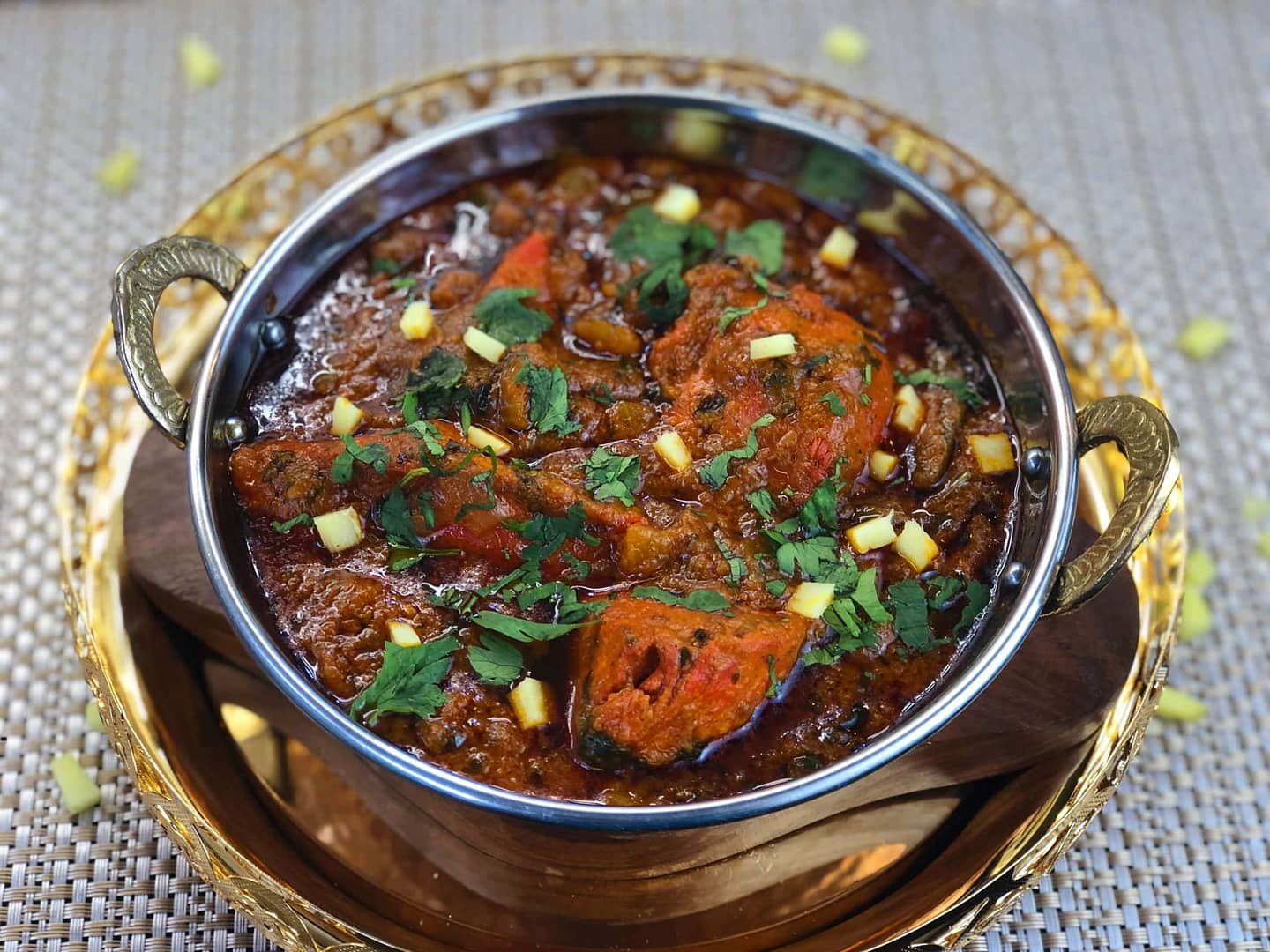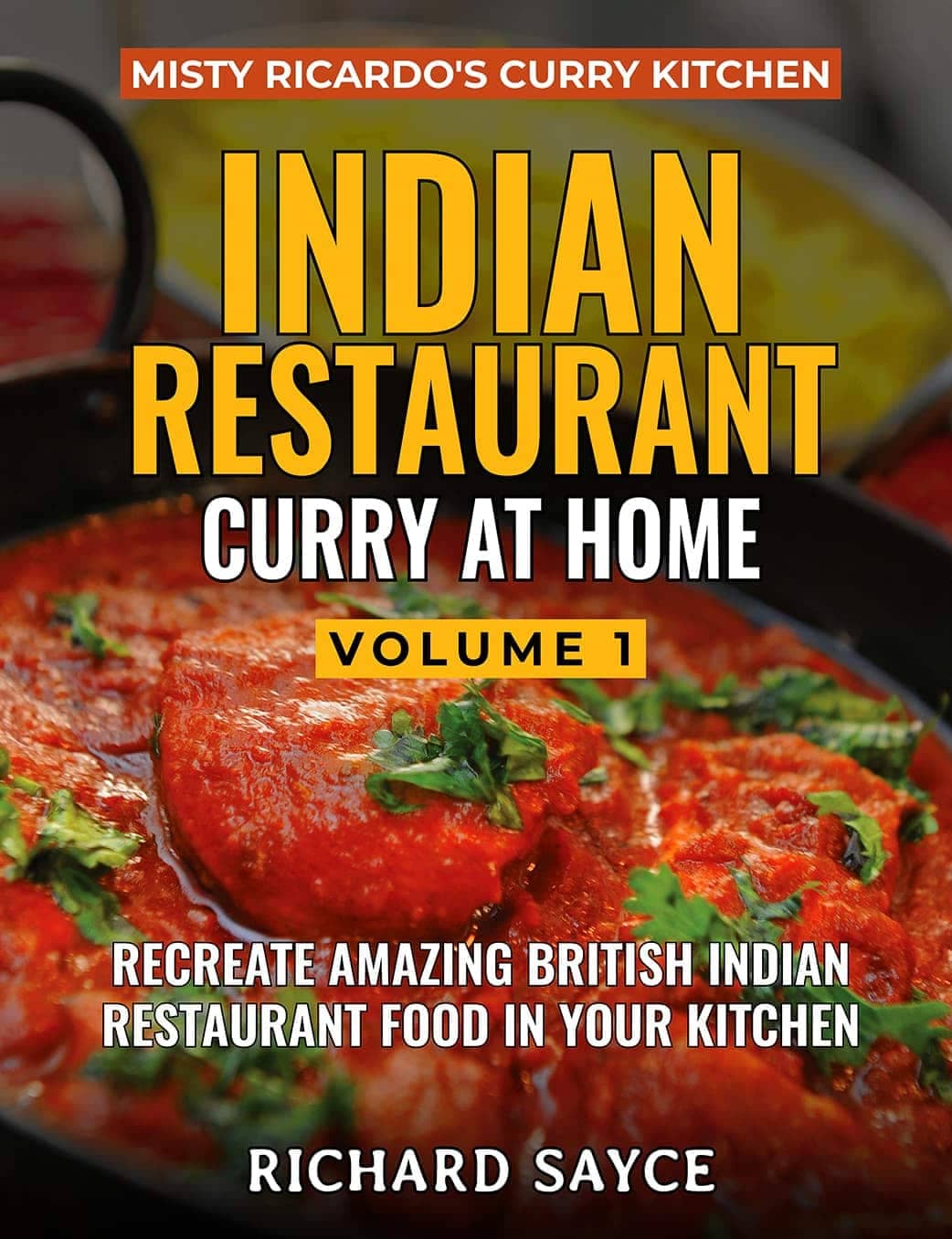In my opinion the hearty and fiery ginger root (the Hindi word is ‘adrak’) merits a specially dedicated curry of its own. My version is a medium-hot curry featuring an abundance of fresh ginger and is complemented with onions, green pepper, tomato, mango chutney, and optional pineapple. Cassia bark, green cardamom, and optional fennel seeds or star anise provide complementary aromatic flavours.
The photo shows the Adrak curry made with Chicken Tikka, but you can of course use any main ingredient you wish to.
This recipe will make enough to feed 1-2 people, and is one of many in my second award-winning book, Indian Restaurant Curry at Home Volume 2.
INGREDIENTS
- 4 TBSP Oil (60ml). Use Butter Ghee or Vegetable Ghee instead or in part for a more rounded flavour
- 10cm Cassia Bark
- Seeds from 3 Green Cardamoms. Discard the outer pods
- 1 Star Anise or 1 tsp Fennel Seeds (optional)
- 75g Onion, thickly sliced
- 75g Green Pepper, cut into small triangles (approx. half a medium pepper)
- 1½ tsp Ginger/Garlic Paste
- 1¼ TBSP fresh Ginger, peeled and cut into small ½cm pieces
- 1 tsp Kasuri Methi
SPACEHOLDER
- 1¼ tsp Mix Powder
- ¾ tsp Kashmiri Chilli Powder (regular chilli powder may be used instead)
- Pinch of Garam Masala (about one eighth of a tsp)
- ¼-½ tsp Salt
- 330ml+ Base Gravy, heated up
- 5-6 TBSP Tomato Paste
- Pre-cooked Chicken, Lamb, Prawns, Vegetables, etc.
- 1-2 TBSP fresh Coriander Stalks, very finely chopped
- 80g Pineapple Chunks (optional)
- 1¼ tsp Lemon or Lime Juice
- 2-3 tsp Mango Chutney
- Fresh Coriander Leaves for garnishing
METHOD
- Add the oil/ghee to a frying pan and heat to medium high.
- Then add the cassia bark, green cardamom seeds, and the optional star anise or fennel seeds.
- Cook for 30-40 seconds to infuse flavour into the oil, stirring frequently.
- Add the onion and green pepper. Fry for about 2 minutes to soften and brown slightly, stirring often.
- Now add the ginger/garlic paste and most of the finely cubed fresh ginger (save some for garnishing). Continue to fry for 15-30 seconds until the sizzling lessens, stirring frequently.
- Next, add the kasuri methi, mix powder, garam masala, Kashmiri chilli powder, and salt.
- Fry for 20-30 seconds, stirring very frequently. Add a little base gravy (e.g. 30ml) if the mixture dries out and sticks to the pan. This avoids burning the spices and gives them enough time to cook properly.
- Add the tomato paste, the fresh coriander stalks, and your choice of main ingredient. Turn up the heat to high and mix together well.
- Then stir in 75ml of base gravy and leave on high heat with no further fiddling until the sauce has reduced a little, and small craters form again around the edges.
SPACEHOLDER
- Next add a second 75ml of base gravy, stirring and scraping the bottom and sides of the pan once when first added. Allow the sauce to reduce slightly and for the cratering to form up again.
- Add 150ml of base gravy, the mango chutney, lemon/lime juice, and the optional pineapple chunks.
- Stir and scrape the pan and leave to cook on high heat for 4-5 minutes. Stir and scrape once or twice to mix the caramelised sauce back in, but do this only to prevent the sauce from sticking too much and burning. It’s important to let the sauce adhere to the bottom and sides of the pan – it produces a great flavour.
- Add a little extra base gravy if needed to achieve a final consistency of medium thickness.
- Remove the whole spices from the curry.
- Taste, and add more salt, lemon, or mango chutney if desired.
- Serve, garnished with the remaining fresh ginger cubes and some finely chopped fresh coriander.
NOTES
- All spoon measurements are level. 1 tsp=5ml. 1 TBSP=15ml





0 Comments